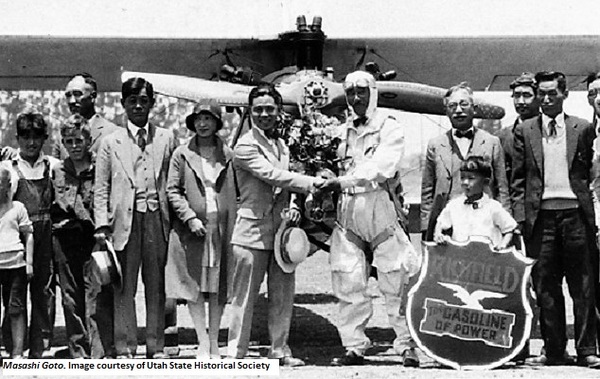Dublin Core
Title
Description
The wreckage of a plane and the body of its young pilot was found in the Uinta Mountains in 1929.
On July 8, 1929 Nymphus Simmons, a sheepherder, found wreckage of a plane and the body of a young man in Dry Canyon near Soapstone Basin in the Uinta Mountains, nearly 8,500 feet above sea level. Simmons contacted some nearby telephone linemen who in turn notified authorities in Park City and Heber. The body proved to be that of missing thirty-two year old pilot Masashi Goto of Los Angeles, an immigrant to the United States from Oita Kyushu, Japan.
Masashi Goto and his friend Takeo Watanabe saved money to design and build the biplane. Goto earned extra money for the plane by cutting lawns. The duo spent three years and $4,500 to construct the fourteen foot long, twenty-two foot wingspan biplane powered by a Pratt and Whitney engine in Watanabe’s garage. Goto and Watanabe’s goal was for Goto to fly across the continents of North America, Europe, and Asia, ending the trip in Japan. The duo hoped that the flight would bring prestige and honor to Japan, and Japanese immigrants to the United States.
On July 4, 1929, Goto landed at the Salt Lake Municipal Airport as part of a transnational flight from Los Angeles to New York City. Members of Utah’s Japanese community greeted Goto at the airport.
After leaving Salt Lake City, Goto headed east past Parley’s Canyon and toward inclement weather. Goto, unable to navigate through a rough thunderstorm in the Uinta’s, either died while attempting a pancake landing or the plane nosedived into the canyon floor. In any case, the impact threw Goto against the instrument panel of the plane, breaking his neck, and probably killing the pilot instantly.
A fading monument erected by the Japanese Association of Utah commemorates Masashi Goto in a spot near his crash just off Utah’s Highway 35 between Kamas and Hanna.
Creator
Source
Image: Masashi Goto. Pilot Masashi Goto landed in the Salt Lake City Airport. It was after this that his plane would crash in the Uinta Mountains. Image courtesy of Utah State Historical Society.
_______________
See Harold Schindler’s Salt Lake Tribune article, dated October 31, 1993, at the Utah History to Go website. Reports of the accident may be found in the following editions of the Salt Lake Tribune: July 9, 1929 and July 10, 1929. See also the Roosevelt Standard for July 11, 1929 on the Utah Digital Newspapers website.

